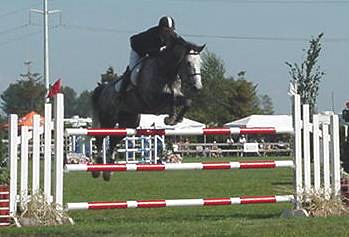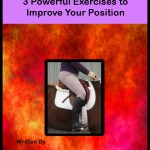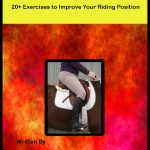Jumping – Finding the Right Spot
Sometimes getting in a little tight can get your horse to ‘snap’ up its knees. But sometimes a little deep can mean a chip and there goes your class. When is a little deep, too deep: when your horse loses its rhythm and causes a loss of flow to the round. Where Should a Horse Take Off
A horse should take off from the sweet spot. This is located at the middle of the fence, the height of the fence away. Huh? If you are jumping a 3 foot fence the ‘sweet spot’ is located 3 feet away from its base. Similarly, a 2’6” fence has a ‘sweet spot’ 2’6” away from its base.
Getting in a little close can cause some problems. A tight spot, or too close to the jump, can lead to the horse being unable to make the distance, or put the correct number of strides in between jumps. It also leads the horse, jumping over its shoulder, and poor form.
Leaving from a long spot, or too far away from the fence, also encourages bad form and rushing at the fences. Jumping from a long spot makes the horse jump flat and it will sometimes hang a leg and take down a rail. Consistently riding from a long spot can encourage poor from and bad jumping style.

![]() photo credit: whiteafrican
photo credit: whiteafrican
What Makes Your Distance
There are five main factors that determine where your take off is for the jump:
- The height of the jump. The take off point should be approximately the height of the jump away from the fence.
- The length of stride. The longer the stride, the longer your ‘spot’ will be. The shorter your stride the closer you will get to the base of the jump.
- The type or depth of footing. If there is deep footing, horses will be more likely to get closer and take off closer to the base of the fence.
- The type of jump. Verticals are usually jumped slightly farther out from the base than oxers. Horses will bascule over the middle of the oxer, so they will have to get closer to the base to satisfy the width of the obstacle.
- Location of the jump in the course. For example, riding a line from a vertical to an oxer is longer than riding from an oxer to a vertical. This is because of the arc the horse makes when jumping. The horse will physically land further into the line when jumping the oxer first so this will give him less usable space between fences.
If you see a tight distance coming don’t abandon your horse. Sit up, keep your eyes up and keep the energy coming from behind with a closed leg. Sitting up will help the horse to use his hindquarters and be able to lift up its front end out of the way. Keeping him balance and able to use his hindquarters will allow him to jump from a deep distance.

 Try these three powerful exercises to get strengthen your position.
Try these three powerful exercises to get strengthen your position.

One thought on “Jumping – Finding the Right Spot”
Comments are closed.